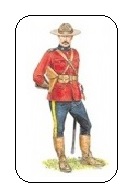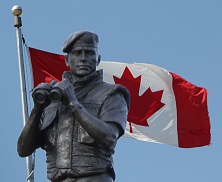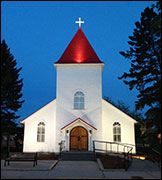True and Fascinating Canadian History
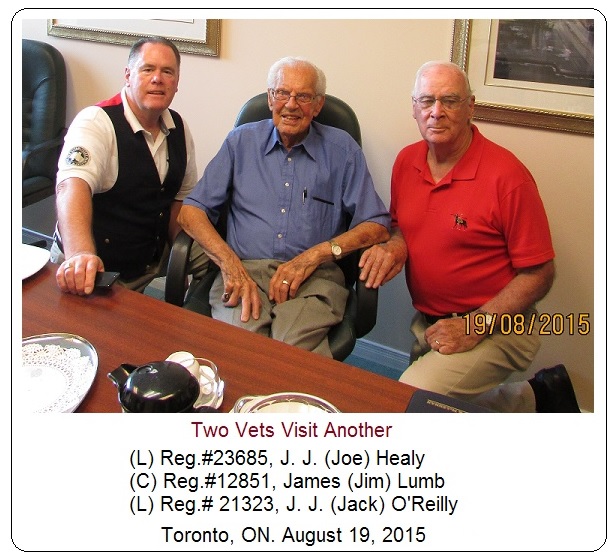
Vet of the Month: September, 2015
Reg.#12851, Sergeant James 'Jim' Lumb
RCMP Vets. Ottawa, ON
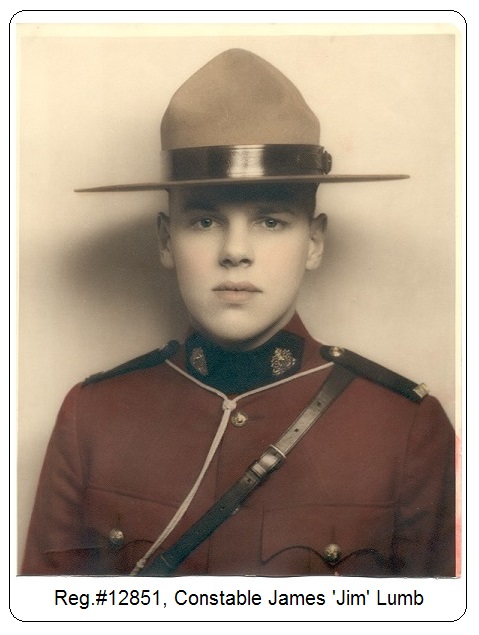
After it has been all boiled down, distilled and fully rinsed, the life of a police officer might be summed up as being quite elementary. For instance, only two people are of any true consequence; the RCMP Commissioner and one's wife. They both know the history of the Force. And, while I would not make the following claim too often, the Commissioner and my wife also share one commonality – occasionally, they are both apt to give commands.
In them ‘ole glory days of the NWMP, the Commissioner would have commanded a Superintendent to mount his horse and ride out to Fort Walsh for the purpose of inspecting the men. And, one day last week, it was my wife who strongly suggested, “Joe, why not saddle up the Honda CRV and patrol down to Fort Toronto to visit long retired Jim Lumb?" "Jim", she said, "must have quite a story to tell.” A few minutes later, and after a flash kiss goodbye, I was on the road driving west.
After my arrival in Toronto, I met RCMP Veteran Jack O’Reilly who also shares a keen interest in the history of the Force. And a short time later, Jack and I were on Jim Lumb's doorstep. What is most remarkable about Jim Lumb is that he is nearly 98 years of age and today he is thought to be the most senior known Veteran of the RCMP. His memory is sharp and his sense of humour is engaging.
Jim's life was shaped by his father. His father, RNWMP Reg.#5741, Sergeant Edward Lumb began his police career in England with the Yorkshire Police. Edward Lumb immigrated to Canada and settled in the west where he met his wife Marie. The Lumb family was raised in Saskatchewan.
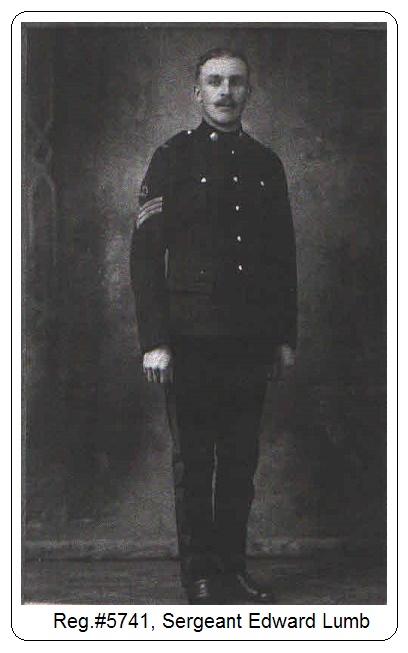
Edward Lumb spent his life in policing -- it was a career mix which began with the RCMP in 1913 then with the Saskatchewan Provincial Police in 1917 then as a Detective with the CNR Police. Edward Lumb retired in 1950. He died in 1970 and he was buried in Victoria, BC.
Jim's memory of his very early days in the Force was remarkable as well as very memorable. He was born on January 17, 1918 in Hanley, SK. He said he was hugely influenced to join the Force by his father. And when he turned nineteen years of age, Jim joined the Force as a Sub Constable in Regina, SK. It was April 1937. While the majority of his Troop mates were older by a couple of years, Jim said his long career in the Force was made rewarding by the hundreds of friends whom he met over the years.
Jim recalled other members of his Squad who underwent their Basic Recruit Training with him at 'Depot'. One Troop mate was Honour Roll #77, Reg.#12845, Constable Edison Alexander Cameron who was killed in Italy while serving during WWII with the No.1 Provost Corps. Other 'ole time pals included Reg.#12845, Norm McPhail and Reg.#12869, V. M. Ralls. Jim thought the majority of his Squad are likely now deceased. When he joined the Force in 1937, Jim also recalled that he first served under O.240, Commissioner Sir James H. MacBrien until he died unexpectedly in 1938 and later under O.271, S. T. Wood who served as Commissioner between 1938 until 1951. Jim also served under O.264, Leonard Hanson Nicholson who commanded the Force as Commissioner beginning in 1951.
Jim said that his Basic Recruit Training consisted of two parts. Part I included foot drill, physical workouts and equitation. During Part I, his Squad lived in the old 'D' Block at 'Depot' which was only partly heated. Some holes around the window frames allowed snow to enter into their rooms.
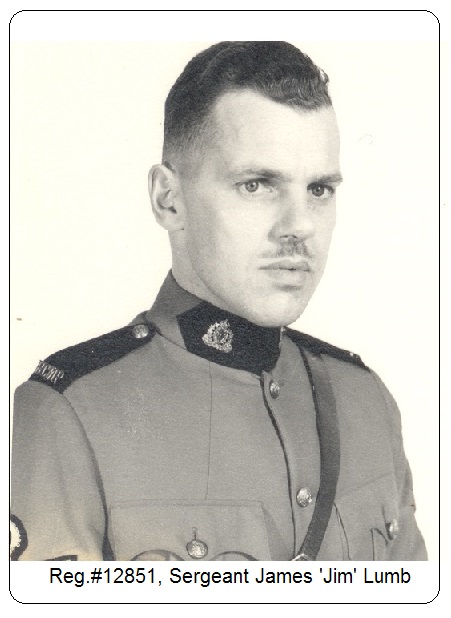
He laughed when he recalled some of the antics of the Equitation Staff and especially Reg.#5426, Sergeant Major George Frederick 'Tim' Griffin in the Riding School. One drill on horseback was when his Troop was told to cross stirrups and to cross their arms while jumping the horses over obstacles. On occasion, S/M Griffin would visit the Riding School. He would stand and watch the Troop then sometimes he would unexpectedly flick a stone at a horse's flank. The obvious effect would be that the horses would skitter causing recruits to lose their grip and to fall off their horse. Then, Sergeant Major Griffin would shout aloud, "Recruit, who gave you permission to dismount?"
As an aside, Sergeant Major Griffin had joined the Force in 1912. He was posted to 'Depot'Division and he served as a Riding Instructor for his entire career. He retired in 1942, then he went on to Hollywood and to movie fame. Corps Sergeant Major George F. Griffin died in 1977. He was buried in the 'Depot' Cemetery.
In 1937, the salary for any RCMP member was so little that saving money was impossible. As a Sub Constable, Jim received $.75 a day for his first year then $1.00 per day for a year as a Second Class Constable then $1.50 a day as a First Class Constable. His pay came in cash and was paid once a month by way of a Pay Parade conducted in front of an Officer. There was also an automatic deduction of 5% for the Widows and Orphans Pension Fund.
After Part I Training, Jim's first posting was to Ottawa, ON. He lived in the Barracks at 'N' Division situated at Rockcliffe, ON. Early each morning, he and many other Constables were transported in an open truck to work. At the time, RCMP 'HQ' was located in the Justice Building on Wellington Ave. not too far from the Parliament Buildings. Jim's job was mostly administrative in nature; reading crime reports, forwarding mail and filing reports from RCMP in the field.
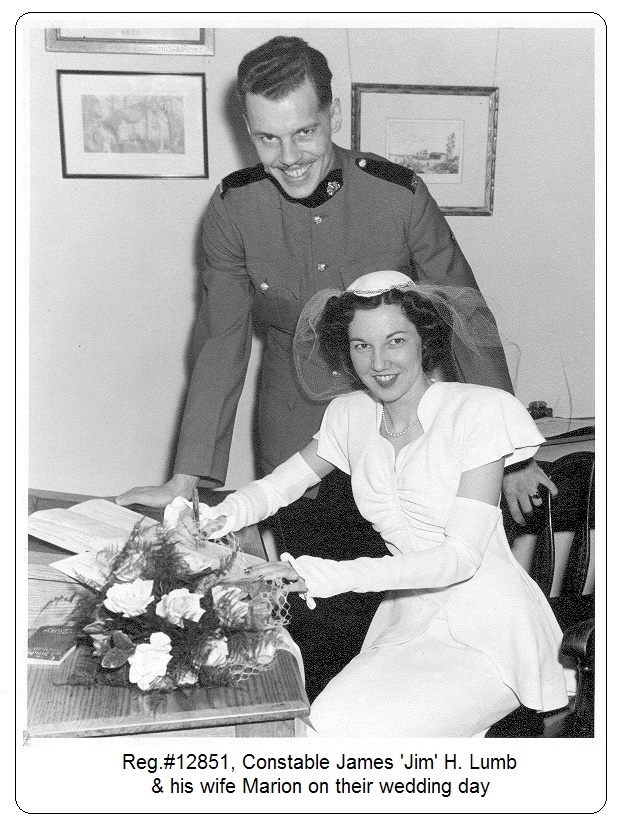
On the one hand, from time to time, Jim thought that he was working in the capacity of a clerk rather than as a police officer. On the other hand, however, it was necessary for him to maintain a Top Secret Security Clearance for the kind of sensitive police reports which he was required to read and process. Jim was able to recall that now deceased O.375, (Reg.#12001) Deputy Commissioner William Kelly was a Sergeant who shared Jim's Ottawa office and nearby in another office was then O.435, (Reg.#12979), Sergeant Len Higgitt who eventually became the fifteenth Commissioner of the Force.
Jim was promoted to First Class Constable at age 21. He was then transferred back to 'Depot' for Part II Basic Training. Jim said that up until he was 21 years of age, he was not permitted to carry a firearm although he had been trained in the use of a rifle. Then, after a few more months at 'Depot', which essentially was a review of Part I, Jim was transferred to Toronto, ON. It was 1942.
In the 1940's the administrative portion of 'O' Division HQ was located on the 2nd floor in the Postal Building at the corner of Yonge & Front Street. In the meantime, RCMP Operations workedout of Town Station Detachment which was located in Toronto's east end at another smaller Postal Station.
Jim worked out of Toronto Town Station Detachment in uniform for about 3 weeks then he was posted to a more complex assignment in CID. He recalled some of his old friends including Max Veitch. At the time, O.375, William 'Bill' Kelly (later Deputy Commissioner) was In Charge of the Black Market Squad which consisted of 10 men. Jim said he worked for Bill Kelly for 3 or4 years. Sleeping Quarters were also located in the Post Office and there were enough beds for eight Constables. When WWII came to an end, the Black Market Squad was disbanded so Jim was transferred to the Criminal Intelligence Unit located at Sullivan Street. The Sullivan building had once served as the Italian Consulate.
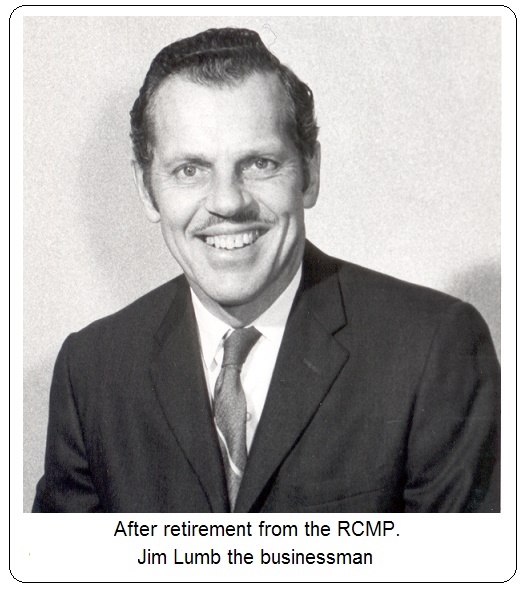
While posted to 'O' Division during the 1940's and the 1950's, Jim's primary focus was Intelligence gathering and Counter Espionage work. In 1954, he was afforded the rare opportunity to attend the Canadian Police College in Ottawa. The CPC course was not only a great learning opportunity, but he met new friends from East & West Pakistan, Jamaica, the USA, the Québec Provincial Police and the Winnipeg City Police. The CPC Course also introduced Jim, for the first time, to the science and psychology of personnel management, leadership development and Executive Education. And, although Jim did not foresee any changes to his RCMP career, Jim's time with the RCMP in Toronto would soon come to a close.
Jim met his wife, Marion Florence Livesley through a mutual and close friend who was O.514,(Reg.#13162) William John 'Barry' Graham. Sadly, Barry died in 1963 at 47 years of age.
The Lumb's were married on December 20, 1945 in Winnipeg, MB which was the hometown of Marion's parents. Soon, Jim's family began to grow. Their children Judy & Barry were born in Toronto. So, thinking ahead, Jim and his wife Marion decided to purchase their first TV to provide his family with some enjoyment while he was on course in 1954 for three months in Ottawa. Jim's career in the Force was progressing very favourably. He had been promoted to Corporal at an unusual early stage, and his promotion to Sergeant came at 17 years service. Most importantly,he had won the support of senior RCMP Officers for further promotions.
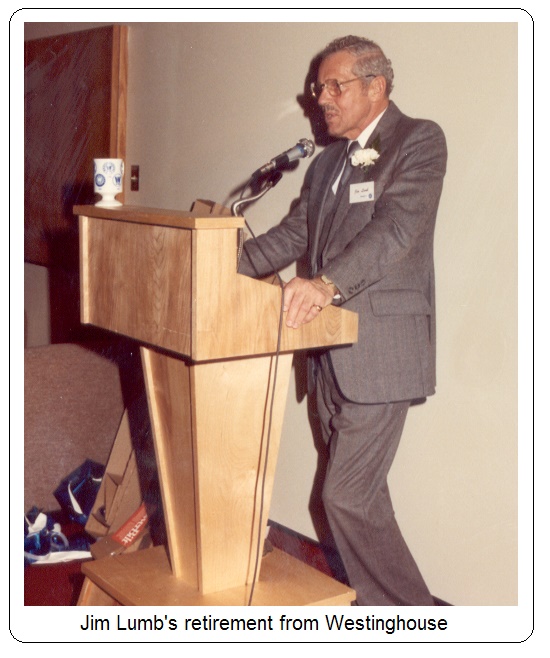
Jim related a quirky incident which involved his only brush with Service Court. One of Jim's constables was assigned to conduct surveillance on a known group of Russians. But, the constable was reputed to enjoy a good time, to party too much and to imbibe. One night, the constable was caught driving while impaired while in an unmarked police car. To add to the danger, the constable was driving against traffic on a one way Toronto street. After his arrest, the constable asked Jim to defend him in Service Court, but Jim knew that any legal assistance would be to no avail. Whenthe constable appeared before the RCMP Trial Officer, he was found guilty on several counts and then he was assessed severe and appropriate penalties.
By 1957, Jim was approaching 20 years of service with the RCMP. He had been very successful andnow he was being considered by the Force for a Commission to the rank of Inspector. But, Jim and Marion decided that they did not want to raise the children with the real possibility of transfers across Canada every 3 years or so. Jim began to think outside the Force.
Jim's health was very good all the time he was in the Force. He had his appendix out at Sunnybrook Hospital (where all RCMP and other military treatments were performed) and he had his tonsils out at an older and smaller hospital in Toronto as an adult. He described his health treatments as primitive as compared to today.
Soon, word got around that Jim was looking for other job opportunities but in the Toronto area. Meanwhile, Commissioner S. T. Wood had retired in Ottawa and was working for the Federal Government in National Defense Procurement. Commissioner Wood approached Jim to say that former member Cam MacDonald (Security Officer at Westinghouse, Hamilton, ON) had died and that Cam's job had become vacant. Commissioner Wood wanted Jim in the Westinghouse job.
Jim and Marion decided that he would retire from the RCMP and then go with new opportunities at Westinghouse. Jim's pension was about 40% of 1957 salary. By 1965, Jim's pension had climbed to $40.00 per month. Westinghouse at that time was well involved in the research of military materials, guidance systems for Mark 4 torpedoes, radar equipment and big contracts with Avro. They employed over 100 engineers working on the Avro with three manufacturing plants in Hamilton, ON and other plants in Trois Riviére, QC and Vancouver, BC. Westinghouse had grown with 15,000 employees on their payroll.
Although Jim began as Westinghouse's Chief Security Officer, he progressed up the ladder andsoon became the Director of Westinghouse's Human Resources. Jim loved his work at Westinghouse. He relied heavily on his past experiences with the RCMP and his new knowledge from the Management Course at the Canadian Police College. Jim only has great memories of his years at Westinghouse. Jim remained with the company for 26 years and he retired from Westinghouse in January 1983. Then, his turned his full attention to Marion, to travel and to his family.
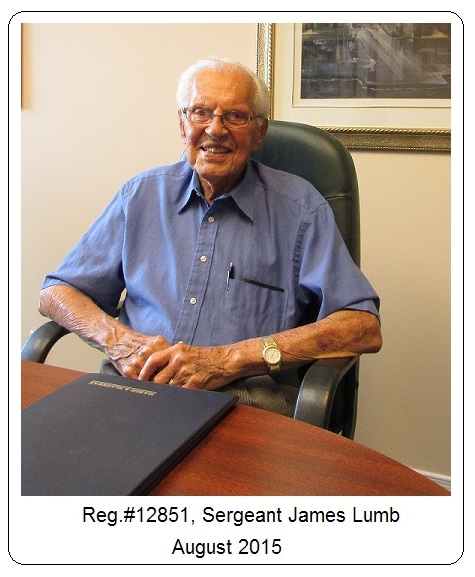
To visit and to interview Jim Lumb was a once in a lifetime opportunity for Jack O'Reilly and me. It was not too surprising for us that he spoke so favourably about his twenty year career in the Force. It was clear that Jim had learned some life secrets from his father; work honestly, remain loyal to the Force and enjoy one's friends. To this list, Jim would also add; marry young and overcompensate the children with love, respect and a good education.
Jim Lumb is a person filled with optimism. Although his wife Marion has since passed away, he greets each new day with vigour and renewed interest in his friends. I will not forget retiredReg.#12851, Sergeant Jim Lumb.
And, I'll be visiting him again.
Reporting from Fort Healy,
J. J. Healy
September 23, 2015
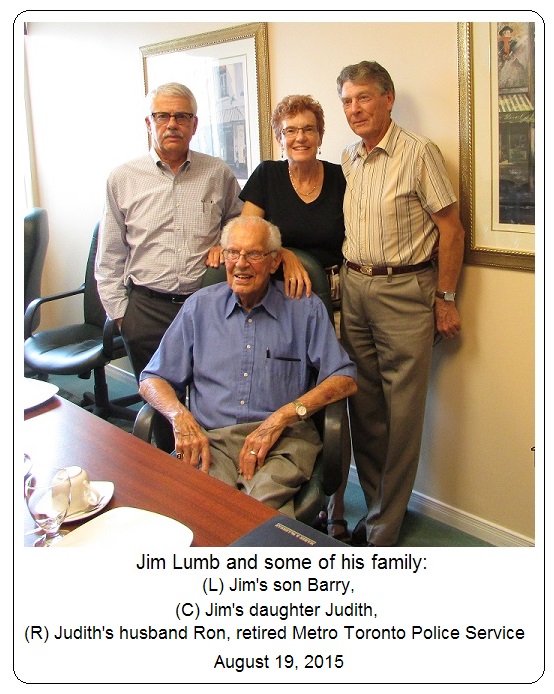
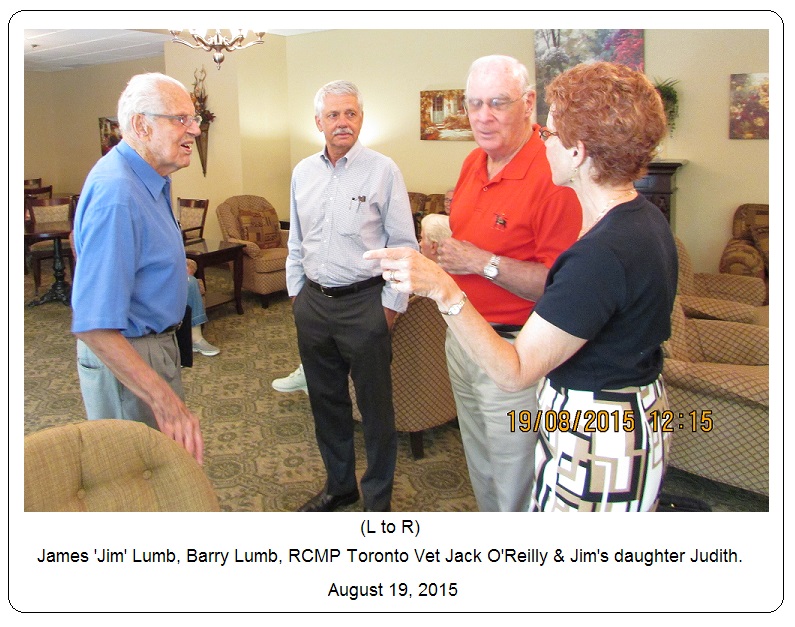
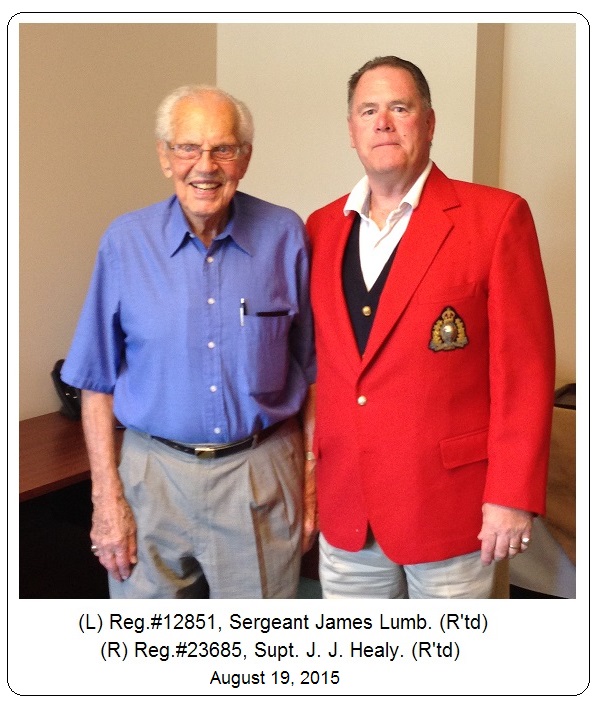
RCMP Veterans Gilbert Gove, Nelson Craig & Charles 'Chuck' Holman are presently all 95 years of age. They were all born in 1920 and each have celebrated their 95th birthday earlier in 2015.
Veterans Mike Pepe & George Fridgen were both born in 1917. This date makes them older than Jim Lumb who was born in 1918. So, at this moment Jim Lumb is the third oldest Veteran. But, Jim does has the lowest Reg. #12851. In this sense, Jim Lumb is the Senior Man.
In the search of RCMP records, thirty (30) RCMP Veterans were found with Reg.#'s lower than Jim Lumb's. Records do not indicate that these Vets have passed away, although they probably have all died. Each of the thirty members only served for a short time. There is no current information on any of them.
Toronto Division is proud that three (3) of the oldest RCMP Vets are members of Toronto Division and two (2) others, Pepe & Fridgen also live in Ontario. The secret formula for a long life must be something in the drinking water.
2015
